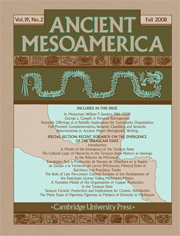Refine listing
Actions for selected content:
Contents
In Memoriam
“Even Jades Are Shattered …” William Timothy Sanders, 1926–2008
-
- Published online by Cambridge University Press:
- 20 November 2008, pp. 157-163
-
- Article
-
- You have access
- HTML
- Export citation
Research Article
HOW I GOT TO WHERE I AM NOW: One thing after another, a (mostly) linear narrative
-
- Published online by Cambridge University Press:
- 20 November 2008, pp. 165-173
-
- Article
- Export citation
DOMESTIC OFFERINGS AT EL PALMILLO: Implications for community organization
-
- Published online by Cambridge University Press:
- 20 November 2008, pp. 175-194
-
- Article
- Export citation
FULL PHONETIC COMPLEMENTATION, SEMANTIC CLASSIFIERS, AND SEMANTICDETERMINATIVES IN ANCIENT MAYAN HIEROGLYPHIC WRITING
-
- Published online by Cambridge University Press:
- 20 November 2008, pp. 195-213
-
- Article
- Export citation
Special Section: Recent Research on the Emergence of the Tarascan State
INTRODUCTION
-
- Published online by Cambridge University Press:
- 20 November 2008, pp. 215-216
-
- Article
- Export citation
A MODEL OF THE EMERGENCE OF THE TARASCAN STATE
-
- Published online by Cambridge University Press:
- 20 November 2008, pp. 217-230
-
- Article
- Export citation
THE CULTURAL LOGIC OF HIERARCHY IN THE TARASCAN STATE: History as ideology in the Relación de Michoacán
-
- Published online by Cambridge University Press:
- 20 November 2008, pp. 231-241
-
- Article
- Export citation
ESTRATEGIAS PARA LA PRODUCCIÓN DE NAVAJAS DE OBSIDIANA EN LA REGIÓN DE ZACAPU Y LA VERTIENTE DEL LERMA (MICHOACAN, MÉXICO) ENTRE EL EPICLÁSICO Y EL POSCLÁSICO TARDÍO
-
- Published online by Cambridge University Press:
- 20 November 2008, pp. 243-264
-
- Article
- Export citation
THE ROLE OF LATE PRE-CONTACT COLONIAL ENCLAVES IN THE DEVELOPMENT OF THE POSTCLASSIC UCAREO VALLEY, MICHOACAN, MEXICO
-
- Published online by Cambridge University Press:
- 20 November 2008, pp. 265-282
-
- Article
- Export citation
A TENTATIVE MODEL OF THE ORGANIZATION OF COPPER PRODUCTION IN THE TARASCAN STATE
-
- Published online by Cambridge University Press:
- 20 November 2008, pp. 283-297
-
- Article
- Export citation
TARASCAN CERAMIC PRODUCTION AND IMPLICATIONS FOR CERAMIC DISTRIBUTION
-
- Published online by Cambridge University Press:
- 20 November 2008, pp. 299-310
-
- Article
- Export citation
THE MANY FACES OF FIGURINES: Figurines as markers of ethnicity in Michoacan
-
- Published online by Cambridge University Press:
- 20 November 2008, pp. 311-318
-
- Article
- Export citation
